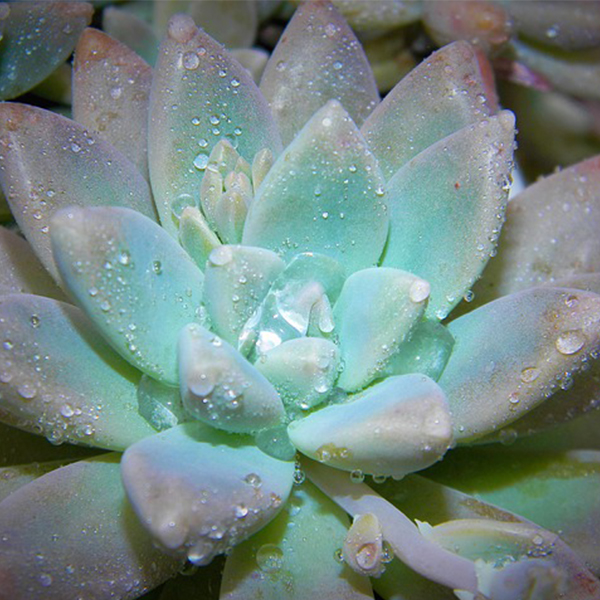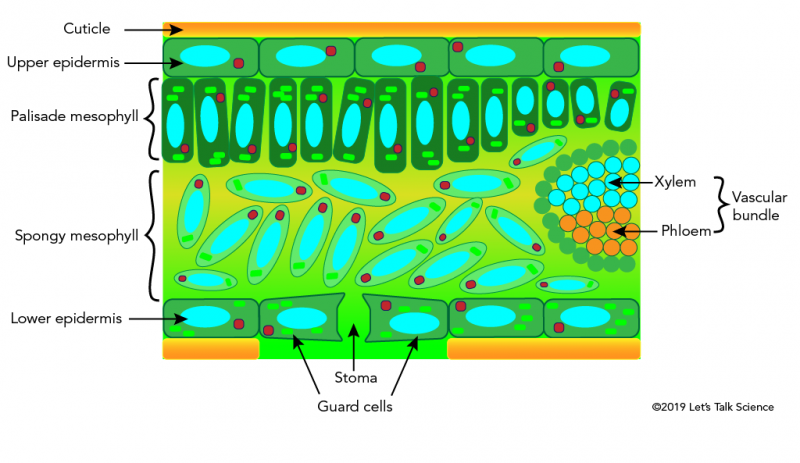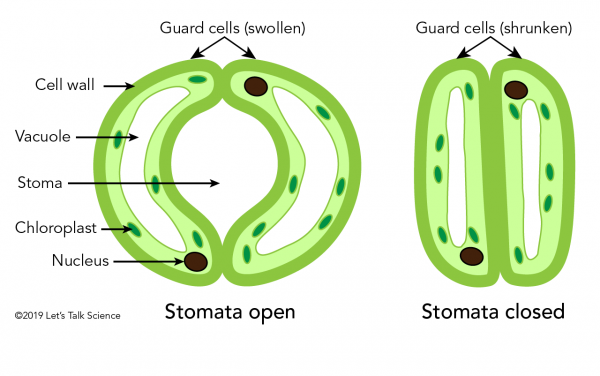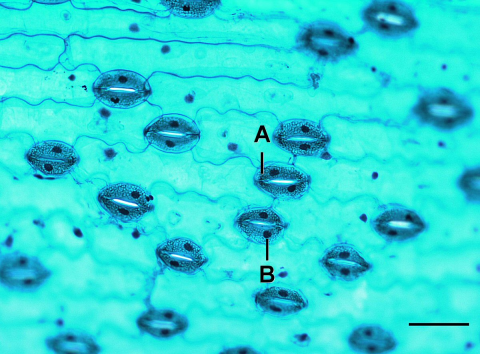How Do Plants Survive in the Desert?

Water droplets on succulent leaves (4639459, Pixabay)

Water droplets on succulent leaves (4639459, Pixabay)
How does this align with my curriculum?
| Grade | Course | Topic |
|---|
Plants need to exchange gases and water with their environment as part of photosynthesis. Some plant cells have evolved specifically for this purpose.
Take a moment and imagine that you live in the Sahara desert. Not in a house, or a tent, but outside, with the sun, sand and vultures. Now imagine that the only water you have access to in your desert oasis is rainwater.
Most areas of the Sahara desert receive less than 2 cm of rain a year. Would you be worried about not getting enough water? You should be! What would you do to make sure that you didn’t end up dehydrated?
Let’s see if the way plants survive in this environment gives us some ideas.
What is the epidermis, and what does it do?
Both plants and animals have bodies made up of many layers of cells. The outermost layer is the epidermis. In humans and animals, the epidermis is our skin. A plant’s epidermis is very important for protection.
It protects the plant from many things:
- desiccation (drying out)
- ultraviolet (UV) radiation
- foreign particles such as viruses
- insects
- many other things that may harm the plant.
What is a plant cuticle?
Most of the protection you just read about comes from the cuticle, a waxy layer over the epidermis. It covers the parts of a plant that are exposed to air.
The cuticle contains polymers called cutin and cutan. It also covers several types of wax. These materials are hydrophobic, which literally means “water fearing.” The hydrophobic materials make the cuticle waterproof. This is useful, because it keeps water from evaporating out of the plant.

What is the stomata, and what does it do?
Like all living things, plants need cells that allow them to exchange gases with their surroundings. Humans breathe in oxygen and exhale carbon dioxide through a process called respiration. Plants do the opposite: they release oxygen and take in carbon dioxide through a process called photosynthesis. Unlike animals, plants do not have mouths to breathe through. The epidermis of a plant contains small openings called stomata (singular: stoma). Each stoma is surrounded by guard cells which can open and close the stoma. Guard cells let gases and water travel in and out of the plant as it needs.

Stomata are found in different locations on different plant species. This means the epidermis of each species has a unique pattern! When plants die in an area with lots of rocks, this pattern can become fossilized on nearby rocks. This pattern is useful for palaeobotanists, scientists who study fossilized plant remains. They can use these patterns to identify and classify the types of plants that were in an area long after the plants have died.

Did you know?
Human fingerprints are completely unique. Though plant fingerprints are sometimes unique to the individual, most often they are unique to a particular plant taxon or group.
Summing up
The evolution of the plant cuticle is one of the most important adaptations in plants. The features you have read about are common to all land plants, not just desert plants. But you can probably see how they are especially useful for plants in the desert!
So let’s get back to you. If you lived in the desert, what would you do to stay hydrated? Wouldn’t it be funny if you could slather yourself in earwax to stay hydrated?
Lucky for us, we can think and move around. This makes it a lot easier to locate water when we need it!
Starting Points
- How can you tell when a plant needs water?
- Have you ever touched plant leaves that feels particularly waxy? What type of plant was it? What is that plant’s natural environment?
- How do you keep yourself dry when it’s raining outside? What materials are best at keeping you dry? Have you worn any materials that both keep you dry and allow moisture from sweat to escape?
- Why do biologists use stomata to identify plants? What additional techniques and tools do biologists use to classify plants?
- If the Earth warms up due to climate change caused by increased carbon dioxide in the atmosphere, how could leaf structure and function be affected?
- What is the function of the leaf cuticle?
- Compare and contrast the function of the leaf epidermis and cuticle with the function of human skin.
- What is the role of leaf stomata in photosynthesis? What conditions stimulate the stomata to open and close?
- In what ways did stomata help early plants be successful?
- How and when did scientists discover leaf stomata?
- This article and supporting resources could be used to support teaching and learning about plant structures and functions, specifically the structure of the leaf system. The concepts introduced include the cells of the leaf, the leaf epidermis and cuticle as well as the processes of gas exchange and how it relates to photosynthesis
- Before introducing this article, the teacher could ask students to collect samples of fresh leaves from indoor or outdoor plants at home or in the neighbourhood. The students could work in small groups to provide detailed descriptions of each of the samples, being sure to describe the look and feel of each leaf.
- The students could read this article and also the TomatosphereTM backgrounder Specialized Cells of the Leaf System.
- Students can observe stomata and compare different leaf stomata patterns by conducting the Additional Inquiry Where does gas exchange take place in plants? (on TomatosphereTM by Let’s Talk Science)
- As a hands-on science extension, students could view prepared slides of leaf cross-sections and identify, draw and label what they observe.
Connecting and Relating
- How can you tell when a plant needs water?
- Have you ever touched plant leaves that feels particularly waxy? What type of plant was it? What is that plant’s natural environment?
- How do you keep yourself dry when it’s raining outside? What materials are best at keeping you dry? Have you worn any materials that both keep you dry and allow moisture from sweat to escape?
Relating Science and Technology to Society and the Environment
- Why do biologists use stomata to identify plants? What additional techniques and tools do biologists use to classify plants?
- If the Earth warms up due to climate change caused by increased carbon dioxide in the atmosphere, how could leaf structure and function be affected?
Exploring Concepts
- What is the function of the leaf cuticle?
- Compare and contrast the function of the leaf epidermis and cuticle with the function of human skin.
- What is the role of leaf stomata in photosynthesis? What conditions stimulate the stomata to open and close?
- In what ways did stomata help early plants be successful?
Nature of Science/Nature of Technology
- How and when did scientists discover leaf stomata?
Teaching Suggestions
- This article and supporting resources could be used to support teaching and learning about plant structures and functions, specifically the structure of the leaf system. The concepts introduced include the cells of the leaf, the leaf epidermis and cuticle as well as the processes of gas exchange and how it relates to photosynthesis
- Before introducing this article, the teacher could ask students to collect samples of fresh leaves from indoor or outdoor plants at home or in the neighbourhood. The students could work in small groups to provide detailed descriptions of each of the samples, being sure to describe the look and feel of each leaf.
- The students could read this article and also the TomatosphereTM backgrounder Specialized Cells of the Leaf System.
- Students can observe stomata and compare different leaf stomata patterns by conducting the Additional Inquiry Where does gas exchange take place in plants? (on TomatosphereTM by Let’s Talk Science)
- As a hands-on science extension, students could view prepared slides of leaf cross-sections and identify, draw and label what they observe.
Learn more
Leaf Structure and Function
This article from ck12.org describes how leaves are made of several kinds of specialized tissues.